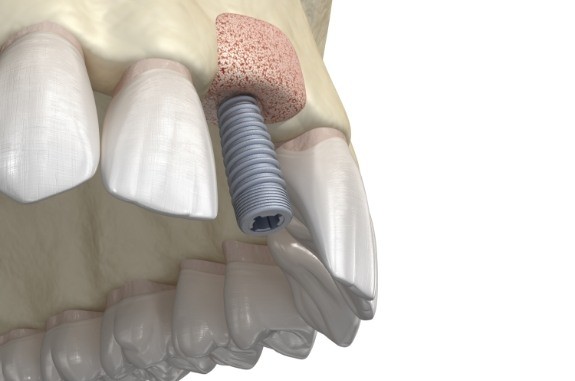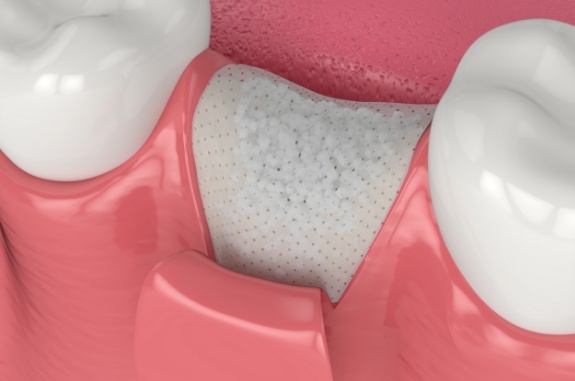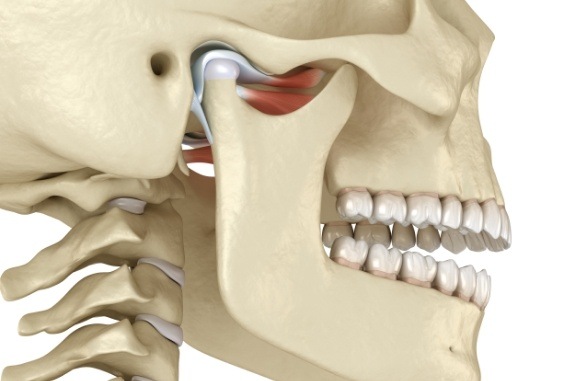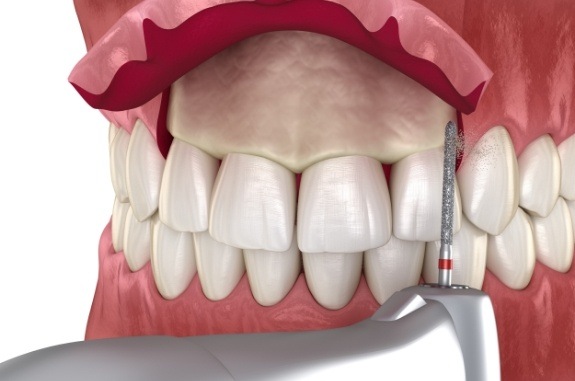Dental Bone Grafting – Clute, TX
Preparing Your Jawbone for Dental Implants
Dental bone grafting is a surgical procedure in which synthetic materials or bone from other people or animals are used to either supplement your bone structure or facilitate bone regeneration. Bone grafting is done to facilitate jawbone growth if you don’t have sufficient bone structure already. The most common reason for this procedure is the desire for dental implants, which is the most effective means of replacing your missing teeth. Call us to learn more about dental bone grafting in Clute.
Why Choose Woodshore Family Dentistry for Dental Bone Grafting?
- Variety of Dental Services in One Location
- In-House Dental Implant Placement
- State-of-the-Art Dental Technology
Bone Grafting for Dental Implants

Dental implants are metallic or titanium frameworks or posts that are drilled into the jawbone under the empty socket of the missing tooth. Once the metal post is in place, your jawbone eventually grows around the post, making it a part of your body. Dental crowns or bridges are then attached over the frame, thereby providing the most effective replacement for missing teeth.
However, to get dental implants, you need to have sufficient bone structure in place. This can be an issue because you start losing bone when you lose your teeth. In the absence of a tooth to support, bone stimulation and growth come to a halt. You can lose as much as 25% of your bone from that region within a year. As such, if you wait a while after the tooth loss to get your dental implants, you may not even have the option to do so.
That’s where bone grafting comes in. During the bone graft, the dentist will use materials from other sources — another animal, another part of your body, another individual, or synthetic materials — and plant them in the affected region. The bone graft will stimulate bone regeneration in the area. Over time, your bone structure will build up naturally and you’ll be able to get dental implants.
Who Needs Dental Implant Treatment?

Anyone can get dental implants as long as they have sufficient bone structure. But, as previously discussed, bone grafting can make up for the lack of bone structure. You should consider dental implant treatment in the following situations:
- If you’ve lost some of your teeth and you want to replace them.
- If you want a permanent solution that’s aesthetically attractive and looks completely natural.
- If you want artificial teeth that function just like real teeth and there’s no risk of them slipping out.
- If you want a completely convenient solution to replace your teeth.
Bone Grafting Surgery — How Is It Performed?

The dentist examines your teeth and oral health. They may also take X-rays and other screening tests to examine your jawbone. Based on this, they’ll discuss your options. You’ll have to decide — along with the dentist — which source you’d like to use for your bone graft. You can get bone grafts from animals like cows, other parts of your body, other people, or synthetic materials. The dentist will discuss the pros and cons of these options so you can decide.
It’s not possible to discuss the exact steps involved in the bone grafting procedure because they will differ based on several factors, including the location, the type of bone graft, and various others. Its primary purpose is to facilitate bone regeneration. Over time, as your body generates bone, it will replace the bone graft material. The dentist may also use collagen and other materials so that your bone regeneration occurs faster, and your bone heals better.
You should ideally do bone grafting as soon as you lose your tooth or go through dental extraction. This will ensure you don’t lose any bone structure and you’ll be able to get dental implants later. But if you’ve already lost bone structure, then the dental bone graft can help with regeneration, but you’ll have to wait for a few months before you can get the dental implants.
While it’s difficult to summarize all of the steps involved in surgery, the following is a brief overview of the basic steps:
- The dentist makes an incision on the gum tissues of the empty socket with the missing tooth.
- The dentist plants the bone graft material in the desired location to aid in bone regeneration.
- The incision is sutured.
The entire surgery is done under anesthesia, so you don’t feel anything. Your bone will heal over time, and you’ll have to go for repeated dental sessions before you can get dental implants.
Advantages of Dental Bone Grafting

A bone graft can help you in the following ways:
- A bone graft immediately after tooth extraction can prevent bone loss.
- After suffering bone loss, it can aid in bone regeneration.
It enables you to explore tooth replacement options like dental implants. This is the best form of tooth replacement because it anchors your tooth, effectively becoming another part of your body.
Is It Possible to Regenerate Lost Bone in the Human Jaw?

It is completely possible to regenerate lost bone in the human jaw. Bone graft surgery uses bone supplements from external sources and plants them in the location with the insufficient jawbone so that your natural bone starts growing again. Eventually, your natural bone will replace the grafting material.
Will Gum Grafts Help Restore My Shrinking Jaw from Bone Loss?

Gum grafts can help restore your shrinking jaw from bone loss. When bone grafts are planted in your gums, they aid in bone growth and regeneration. This process counters the effects of bone loss, allowing your jaws to grow out again.
Dental Bone Graft Cost

The cost of a dental bone graft is really difficult to narrow down because it depends on various factors such as the location of the bone graft, the amount of grafting material necessary, and especially the source of the bone graft material.
A synthetic bone graft is the cheapest, generally costing between $250 to $1100. Bone grafting using the patient’s bone or another individual’s bone may cost between $2,000 and $3,000. This is simply the cost of the bone graft alone. You will also have to pay additional for screening tests, anesthesia, and other related procedures.
I Need a Checkup & Cleaning I Need a Dentist for My Child I am Worried About Gum Disease I Have a Cavity or Broken Tooth I am Missing One or More Teeth I Want to Enhance My Smile I Want a Straighter Smile I am Concerned About Sleep Apnea I am Scared of the Dentist I Have Pain in My Jaw I Have a Dental Emergency View Our Services


